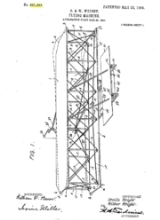
The Wright brothers patent war
Encyclopedia
The Wright brothers
were two Americans
who are widely credited with inventing and building the world's first successful airplane
and making the first controlled, powered and sustained heavier-than-air human flight on December 17, 1903.
In 1906 the Wrights received a patent for their method of flight control and fiercely defended it in the years afterward, suing foreign and domestic aviators and companies, especially Glenn Curtiss
, in an attempt to collect licensing fees. The legal threat suppressed development of the U.S. aviation industry. Letters Wilbur Wright wrote to Octave Chanute
in January 1910 offer a glimpse into the Wrights' proprietary feeling about their work:
"It is not disputed that every person who is using this system today owes it to us and to us alone. The French aviators freely admit it." In another letter Wilbur said:
"It is our view that morally the world owes its almost universal use of our system of lateral control entirely to us. It is also our opinion that legally it owes it to us."
After World War I
began, the federal government pressured the U.S. aviation industry to form an organization that allowed sharing of aviation patents.
. Their breakthrough discovery was the simultaneous use of roll control (with wing-warping) and yaw control (with a rear rudder). A forward elevator controlled pitch. In March 1903 they applied for a patent
on their method of control. The application, which they wrote themselves, was rejected. In early 1904, they hired Ohio patent attorney Henry Toulmin
, and on May 22, 1906, they were granted U.S. Patent 821393 for a "Flying Machine".
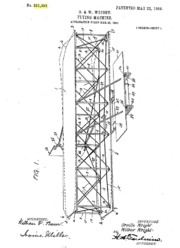 The patent's importance lies in its claim of a new and useful method of controlling a flying machine, powered or not. The technique of wing-warping is described, but the patent explicitly states that other methods instead of wing-warping could be used for adjusting the outer portions of a machine's wings to different angles on the right and left sides to achieve lateral (roll) control.
The patent's importance lies in its claim of a new and useful method of controlling a flying machine, powered or not. The technique of wing-warping is described, but the patent explicitly states that other methods instead of wing-warping could be used for adjusting the outer portions of a machine's wings to different angles on the right and left sides to achieve lateral (roll) control.
The concept of lateral control was basic to all aircraft designs; without it they could not be easily or safely controlled in flight.
The broad protection intended by this patent succeeded when the Wrights won patent infringement lawsuits against Glenn Curtiss
and other early aviators who devised aileron
s to emulate lateral control described in the patent and demonstrated by the Wrights in their 1908 public flights. U.S. courts decided that ailerons were also covered by the patent.
In 1908, the brothers warned Glenn Curtiss
not to infringe their patent by profiting from flying or selling aircraft that used ailerons. Curtiss refused to pay license fees to the Wrights and sold an airplane to the Aeronautic Society of New York in 1909. The Wrights filed a lawsuit, beginning a years-long legal conflict. They also sued foreign aviators who flew at U.S. exhibitions, including the leading French aviator Louis Paulhan
. The Curtiss people derisively suggested that if someone jumped in the air and waved his arms, the Wrights would sue. The brothers' licensed European companies, which owned foreign patents the Wrights had received, sued manufacturers in their countries. The European lawsuits were only partly successful. Despite a pro-Wright ruling in France, legal maneuvering dragged on until the patent expired in 1917. A German court ruled the patent not valid due to prior disclosure in speeches by Wilbur Wright in 1901 and Octave Chanute
in 1903. In the U.S. the Wrights made an agreement with the Aero Club of America
to license airshows which the Club approved, freeing participating pilots from a legal threat. Promoters of approved shows paid fees to the Wrights. The Wright brothers won their initial case against Curtiss in February 1913, but the decision was appealed.
The brothers wrote to Samuel F Cody in the UK, making a claim that he had infringed their patents but Cody stated that he had used wing-warping on his man-carrying kite]s before their flights.
The Wrights' preoccupation with the legal issue hindered their development of new aircraft designs, and by 1911 Wright aircraft were inferior to those made by other firms in Europe. Indeed, aviation development in the US was suppressed to such an extent that when the U.S. entered World War I no acceptable American-designed aircraft were available, and the U.S. forces were compelled to use French machines.
In January 1914, a U.S. Circuit Court of Appeals upheld the verdict in favor of the Wrights against the Curtiss company, which continued to avoid penalties through legal tactics.
and the Curtiss Company, had effectively blocked the building of new airplanes, which were desperately needed as the United States was entering World War I
. The U.S. government, as a result of a recommendation of a committee formed by Franklin D. Roosevelt
, then Assistant Secretary of the Navy
, pressured the industry to form a cross-licensing organization (in other terms a Patent pool
), the Manufacturer's Aircraft Association.
All aircraft manufacturers were required to join the association, and each member was required to pay a comparatively small blanket fee (for the use of aviation patents) for each airplane manufactured, of that the major part would go to the Wright-Martin
and Curtiss
companies, until their respective patents expire. This arrangement was designed to last only for the duration of the war, but in 1918, the litigation was never renewed. By this time, Wilbur had died (in May 1912) and Orville had sold his interest in the Wright Company to a group of New York financiers (in October 1915) and retired from the business. The "patent war" had come to an end.
The Manufacturers Aircraft Association was an early example of a government-enforced Patent pool
. It has been used as an example in recent cases, such as dealing with HIV
antiretroviral drug
patents to give access to otherwise expensive treatments in Africa.
Wright brothers
The Wright brothers, Orville and Wilbur , were two Americans credited with inventing and building the world's first successful airplane and making the first controlled, powered and sustained heavier-than-air human flight, on December 17, 1903...
were two Americans
United States
The United States of America is a federal constitutional republic comprising fifty states and a federal district...
who are widely credited with inventing and building the world's first successful airplane
Fixed-wing aircraft
A fixed-wing aircraft is an aircraft capable of flight using wings that generate lift due to the vehicle's forward airspeed. Fixed-wing aircraft are distinct from rotary-wing aircraft in which wings rotate about a fixed mast and ornithopters in which lift is generated by flapping wings.A powered...
and making the first controlled, powered and sustained heavier-than-air human flight on December 17, 1903.
In 1906 the Wrights received a patent for their method of flight control and fiercely defended it in the years afterward, suing foreign and domestic aviators and companies, especially Glenn Curtiss
Glenn Curtiss
Glenn Hammond Curtiss was an American aviation pioneer and a founder of the U.S. aircraft industry. He began his career as a bicycle then motorcycle builder and racer, later also manufacturing engines for airships as early as 1906...
, in an attempt to collect licensing fees. The legal threat suppressed development of the U.S. aviation industry. Letters Wilbur Wright wrote to Octave Chanute
Octave Chanute
Octave Chanute was a French-born American railway engineer and aviation pioneer. He provided the Wright brothers with help and advice, and helped to publicize their flying experiments. At his death he was hailed as the father of aviation and the heavier-than-air flying machine...
in January 1910 offer a glimpse into the Wrights' proprietary feeling about their work:
"It is not disputed that every person who is using this system today owes it to us and to us alone. The French aviators freely admit it." In another letter Wilbur said:
"It is our view that morally the world owes its almost universal use of our system of lateral control entirely to us. It is also our opinion that legally it owes it to us."
After World War I
World War I
World War I , which was predominantly called the World War or the Great War from its occurrence until 1939, and the First World War or World War I thereafter, was a major war centred in Europe that began on 28 July 1914 and lasted until 11 November 1918...
began, the federal government pressured the U.S. aviation industry to form an organization that allowed sharing of aviation patents.
The patent
During their experiments of 1902 the Wrights succeeded in controlling their glider in all three axes of flight: pitch, roll and yawFlight dynamics
Flight dynamics is the science of air vehicle orientation and control in three dimensions. The three critical flight dynamics parameters are the angles of rotation in three dimensions about the vehicle's center of mass, known as pitch, roll and yaw .Aerospace engineers develop control systems for...
. Their breakthrough discovery was the simultaneous use of roll control (with wing-warping) and yaw control (with a rear rudder). A forward elevator controlled pitch. In March 1903 they applied for a patent
Patent application
A patent application is a request pending at a patent office for the grant of a patent for the invention described and claimed by that application. An application consists of a description of the invention , together with official forms and correspondence relating to the application...
on their method of control. The application, which they wrote themselves, was rejected. In early 1904, they hired Ohio patent attorney Henry Toulmin
Harry Aubrey Toulmin, Sr.
Harry Aubrey Toulmin, Sr. was the American lawyer located in Springfield, Ohio, who wrote the "flying machine" patent application that resulted in the patent granted to Dayton inventors Wilbur and Orville Wright on May 22, 1906....
, and on May 22, 1906, they were granted U.S. Patent 821393 for a "Flying Machine".

The concept of lateral control was basic to all aircraft designs; without it they could not be easily or safely controlled in flight.
The broad protection intended by this patent succeeded when the Wrights won patent infringement lawsuits against Glenn Curtiss
Glenn Curtiss
Glenn Hammond Curtiss was an American aviation pioneer and a founder of the U.S. aircraft industry. He began his career as a bicycle then motorcycle builder and racer, later also manufacturing engines for airships as early as 1906...
and other early aviators who devised aileron
Aileron
Ailerons are hinged flight control surfaces attached to the trailing edge of the wing of a fixed-wing aircraft. The ailerons are used to control the aircraft in roll, which results in a change in heading due to the tilting of the lift vector...
s to emulate lateral control described in the patent and demonstrated by the Wrights in their 1908 public flights. U.S. courts decided that ailerons were also covered by the patent.
Patent war
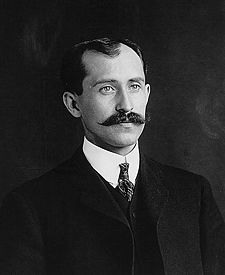 |
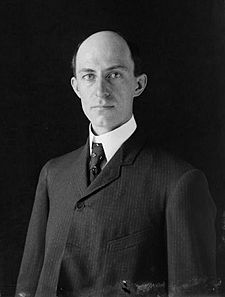 |
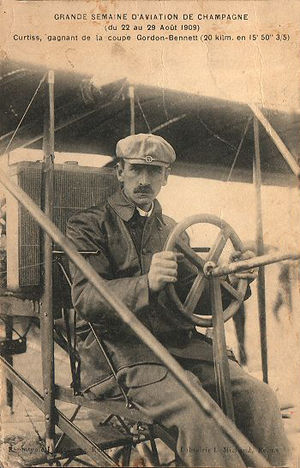 |
| Orville Wright | Wilbur Wright | Glenn Curtiss |
|---|
In 1908, the brothers warned Glenn Curtiss
Glenn Curtiss
Glenn Hammond Curtiss was an American aviation pioneer and a founder of the U.S. aircraft industry. He began his career as a bicycle then motorcycle builder and racer, later also manufacturing engines for airships as early as 1906...
not to infringe their patent by profiting from flying or selling aircraft that used ailerons. Curtiss refused to pay license fees to the Wrights and sold an airplane to the Aeronautic Society of New York in 1909. The Wrights filed a lawsuit, beginning a years-long legal conflict. They also sued foreign aviators who flew at U.S. exhibitions, including the leading French aviator Louis Paulhan
Louis Paulhan
Isidore Auguste Marie Louis Paulhan, known as Louis Paulhan, was a pioneering French aviator who in 1910 flew "Le Canard", the world's first seaplane, designed by Henri Fabre....
. The Curtiss people derisively suggested that if someone jumped in the air and waved his arms, the Wrights would sue. The brothers' licensed European companies, which owned foreign patents the Wrights had received, sued manufacturers in their countries. The European lawsuits were only partly successful. Despite a pro-Wright ruling in France, legal maneuvering dragged on until the patent expired in 1917. A German court ruled the patent not valid due to prior disclosure in speeches by Wilbur Wright in 1901 and Octave Chanute
Octave Chanute
Octave Chanute was a French-born American railway engineer and aviation pioneer. He provided the Wright brothers with help and advice, and helped to publicize their flying experiments. At his death he was hailed as the father of aviation and the heavier-than-air flying machine...
in 1903. In the U.S. the Wrights made an agreement with the Aero Club of America
Aero Club of America
The Aero Club of America was a social club formed in 1905 by Charles Glidden and others to promote aviation in America. It was the parent organization of numerous state chapters, the first being the Aero Club of New England. It thrived until 1923, when it transformed into the National Aeronautic...
to license airshows which the Club approved, freeing participating pilots from a legal threat. Promoters of approved shows paid fees to the Wrights. The Wright brothers won their initial case against Curtiss in February 1913, but the decision was appealed.
The brothers wrote to Samuel F Cody in the UK, making a claim that he had infringed their patents but Cody stated that he had used wing-warping on his man-carrying kite]s before their flights.
The Wrights' preoccupation with the legal issue hindered their development of new aircraft designs, and by 1911 Wright aircraft were inferior to those made by other firms in Europe. Indeed, aviation development in the US was suppressed to such an extent that when the U.S. entered World War I no acceptable American-designed aircraft were available, and the U.S. forces were compelled to use French machines.
In January 1914, a U.S. Circuit Court of Appeals upheld the verdict in favor of the Wrights against the Curtiss company, which continued to avoid penalties through legal tactics.
The patent pool solution
In 1917, the two major patent holders, the Wright CompanyWright Company
The Wright Company was the commercial aviation business venture of the Wright Brothers, established by them in 1909 in conjunction with several prominent industrialists from New York and Detroit with the intention of capitalizing on their invention of the practical airplane. It maintained a...
and the Curtiss Company, had effectively blocked the building of new airplanes, which were desperately needed as the United States was entering World War I
World War I
World War I , which was predominantly called the World War or the Great War from its occurrence until 1939, and the First World War or World War I thereafter, was a major war centred in Europe that began on 28 July 1914 and lasted until 11 November 1918...
. The U.S. government, as a result of a recommendation of a committee formed by Franklin D. Roosevelt
Franklin D. Roosevelt
Franklin Delano Roosevelt , also known by his initials, FDR, was the 32nd President of the United States and a central figure in world events during the mid-20th century, leading the United States during a time of worldwide economic crisis and world war...
, then Assistant Secretary of the Navy
Assistant Secretary of the Navy
Assistant Secretary of the Navy is the title given to certain civilian senior officials in the United States Department of the Navy....
, pressured the industry to form a cross-licensing organization (in other terms a Patent pool
Patent pool
In patent law, a patent pool is a consortium of at least two companies agreeing to cross-license patents relating to a particular technology. The creation of a patent pool can save patentees and licensees time and money, and, in case of blocking patents, it may also be the only reasonable method...
), the Manufacturer's Aircraft Association.
All aircraft manufacturers were required to join the association, and each member was required to pay a comparatively small blanket fee (for the use of aviation patents) for each airplane manufactured, of that the major part would go to the Wright-Martin
Wright-Martin
Wright-Martin was a short-lived aircraft manufacturing business venture between the Wright Company and Glenn L. Martin....
and Curtiss
Curtiss Aeroplane and Motor Company
Curtiss Aeroplane and Motor Company was an American aircraft manufacturer that went public in 1916 with Glenn Hammond Curtiss as president. Throughout the 1920s and 1930s, the company was the largest aircraft manufacturer in the United States...
companies, until their respective patents expire. This arrangement was designed to last only for the duration of the war, but in 1918, the litigation was never renewed. By this time, Wilbur had died (in May 1912) and Orville had sold his interest in the Wright Company to a group of New York financiers (in October 1915) and retired from the business. The "patent war" had come to an end.
Aftermath
The lawsuits damaged the public image of the Wright brothers, who were generally regarded before this as heroes. Critics said the brothers actions may have retarded the development of aviation, and compared their actions unfavorably to European inventors, who worked more openly.The Manufacturers Aircraft Association was an early example of a government-enforced Patent pool
Patent pool
In patent law, a patent pool is a consortium of at least two companies agreeing to cross-license patents relating to a particular technology. The creation of a patent pool can save patentees and licensees time and money, and, in case of blocking patents, it may also be the only reasonable method...
. It has been used as an example in recent cases, such as dealing with HIV
HIV
Human immunodeficiency virus is a lentivirus that causes acquired immunodeficiency syndrome , a condition in humans in which progressive failure of the immune system allows life-threatening opportunistic infections and cancers to thrive...
antiretroviral drug
Antiretroviral drug
Antiretroviral drugs are medications for the treatment of infection by retroviruses, primarily HIV. When several such drugs, typically three or four, are taken in combination, the approach is known as Highly Active Antiretroviral Therapy, or HAART...
patents to give access to otherwise expensive treatments in Africa.
See also
- Selden patent, another vehicular technology patent lawsuit of the same time period

